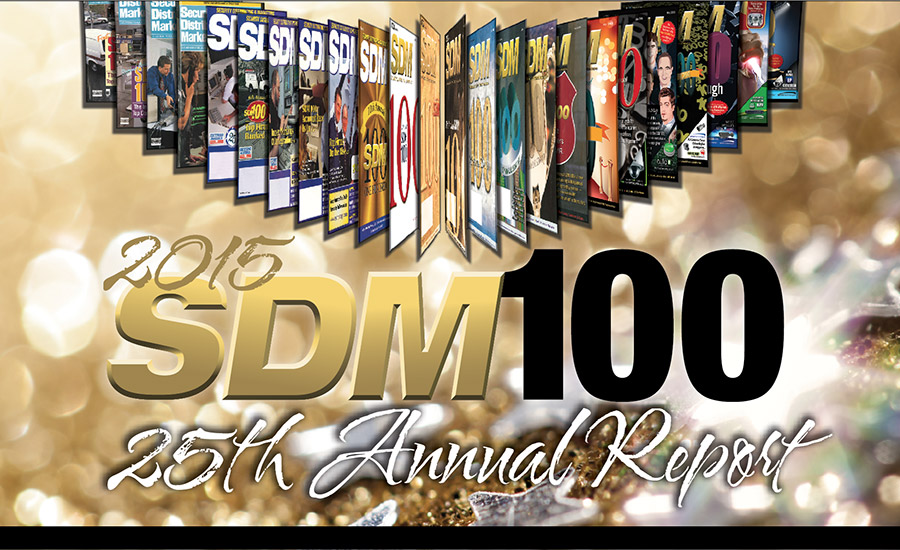It’s used in many different ways by different people, but the primary objective of the SDM 100 remains the same after 25 years: to measure consumer dollars gained by alarm companies, in order to present an account of the size of the market captured by the 100 largest security providers.
Just google “SDM 100” and you’ll get close to one million results. The SDM 100, a report that ranks the 100 largest electronic security companies by their recurring monthly revenue, is a gold standard in the security industry today.
In 1991, however, when SDM Magazine first undertook the project of ranking the companies that offer installation, service and monitoring to residential and commercial customers, it was unheard of to share financial data in such a public way. The majority of alarm companies were “mom and pop” businesses — owned by families often in their second- or third-generation of management, locally based, and privately held. SDM required these companies to report their total gross revenue, number of subscriber accounts, installation volume, and more. One alarm dealer reportedly commented that he would never give up such confidential information. In the end, he did. And even though several other owner-operators felt the same way and neither reported nor were ever to be ranked on the SDM 100, the majority of dealers came around to it.
“Above and beyond the usefulness of the specific data in the SDM 100, the report played an important role in encouraging the industry to share information for collective benefit,” says Michael Barnes, founding partner of Barnes Associates Inc., St. Louis, Mo., an advisory and consulting firm that specializes in the security alarm industry. “I am sure the editors involved in the earlier years can attest to how difficult it was to convince the larger companies to disclose the required information. SDM’s tenacity in developing this list and the value it provides demonstrated the usefulness of this type of sharing and helped a number of other efforts, including our performance benchmarking program.” Barnes helped SDM initially develop some of the report’s ranking criteria.
The very first SDM 100 ranked companies by their total gross annual revenue. The article, published in May 1991, opened with the sentiment: “There is a time when every maturing industry must come out of its shell. This is particularly true in the alarm industry where changes have captured the attention of the public, as well as electronic security professionals.”
The first year included 100 companies, but they were divided into two lists: Commercially Focused Companies (topped by ADT Security Systems Inc., Honeywell Protection Services Div., and Wells Fargo Alarm Services) and Residentially Focused Companies (topped by The Alert Centre, Westec Security Inc., and Dictograph Franchise Corp.) The very next year, in 1992, the two lists were combined into one because, after all, most alarm companies had a general focus on both markets.
Although the SDM 100 began reporting RMR by individual company in 1995, it wasn’t until 2007 when the rankings began to be based on RMR, rather than on total annual gross revenue. SDM reported at the time: “It is the revenue associated with the long-term agreement between the alarm company and its subscriber. RMR is the language of alarm company executives and is more meaningful in comparative analysis among industry peers.” Basing the SDM 100 on RMR also helped delineate the distinction between security alarm companies and security systems integrators, the latter of which were being ranked in SDM’s Top Systems Integrators Report, introduced in 1996.
“The SDM 100 has consistently been one of the industry’s most important reference tools,” Barnes says. “It is by far the most accurate and detailed look into the top players, who collectively represent over half of the market (by RMR).”
As this issue marks the 25th edition of the SDM 100, it presented a time to reflect on how the report got started, how it changed and evolved, and its usefulness to the industry at large, as well as those who observe, analyze, and fund the security industry.
“Having an independent source compile this information, particularly when it is a highly respected trade journal, brings credibility to the industry and helps outsiders better understand the space,” Barnes adds. “This is particularly important for the capital markets, which are very much needed to fund the industry’s growth.”
This is a momentous year for SDM, as we celebrate the 25th anniversary of the SDM 100, and the 10th anniversary of the Gala. Back in 1991, when the SDM 100 was first published, it marked the beginnings of a maturing industry with a bright future. Over the years, the SDM 100 has been used by financial institutions and investors, as well as the entire security industry, to track performance, identify trends, and benchmark growth. We are very proud of the positive impact that this report has made on the security alarm industry.
More Online
All 25 editions, from 1991 to 2015, of the SDM 100 (in PDF format) are now available online at: www.SDMmag.com/25thSDM100.




